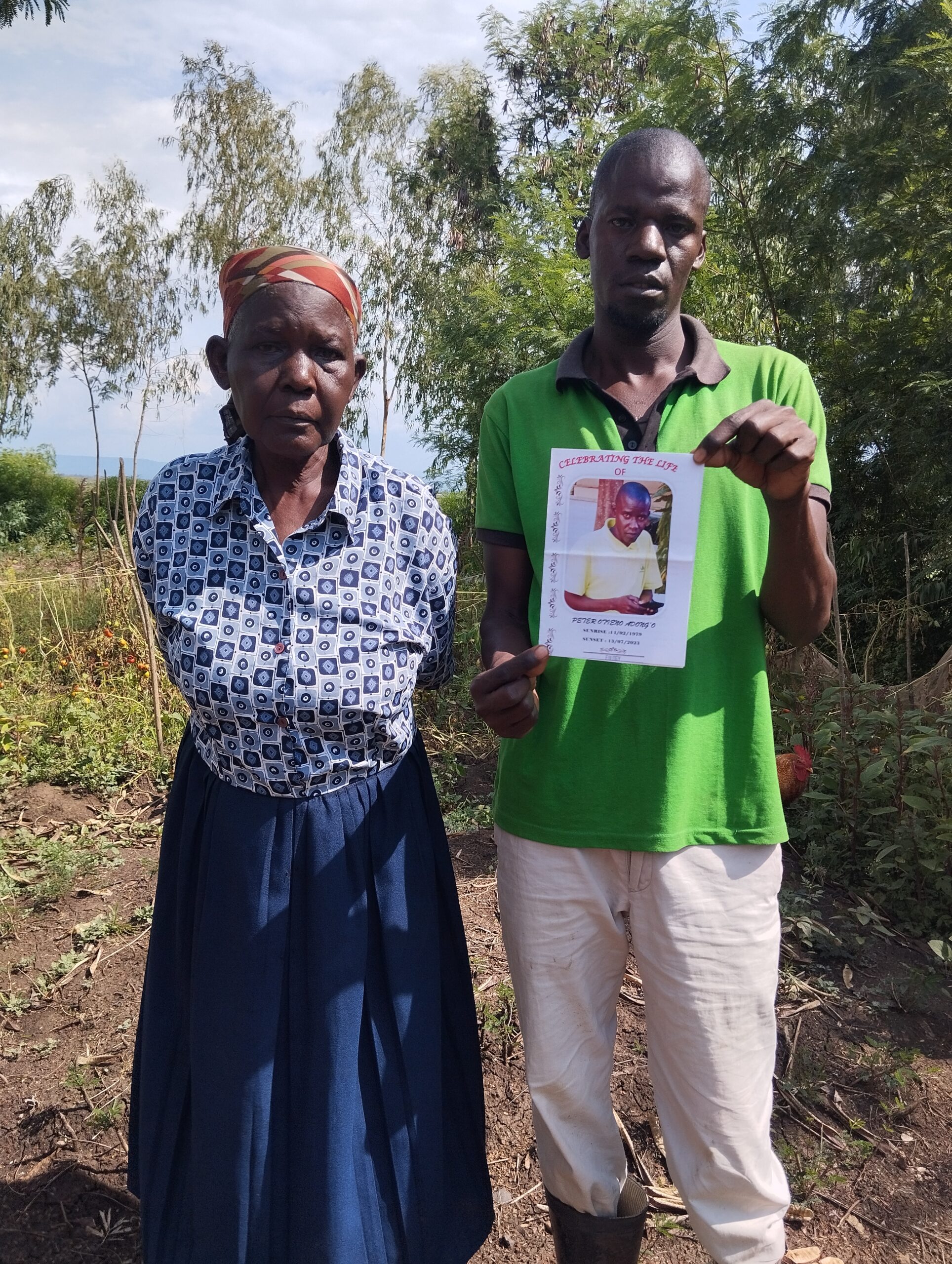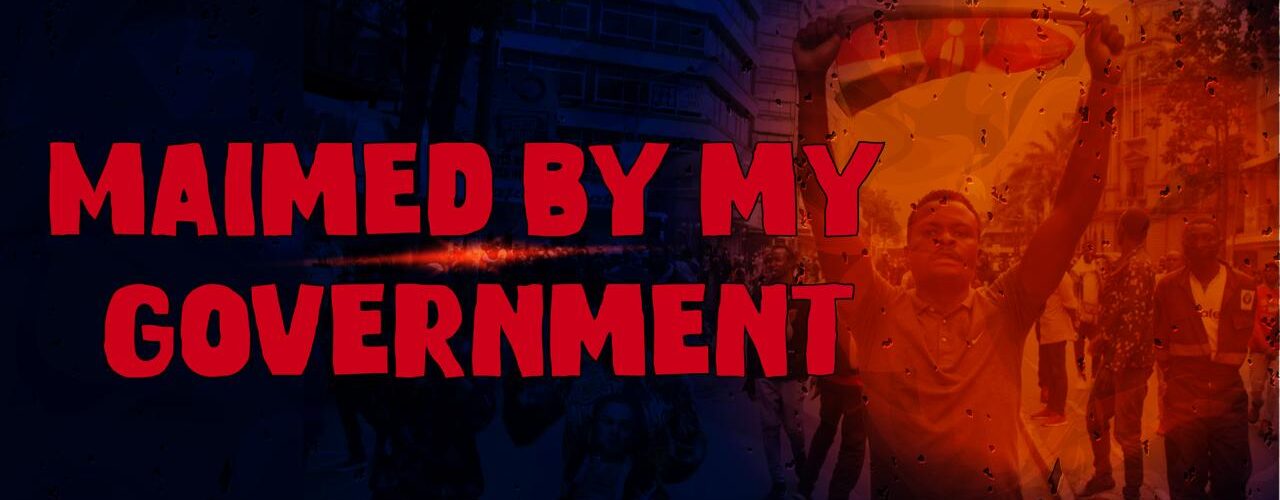When President William Ruto took office in 2022, he vowed that no extrajudicial killings would occur under his administration. Barely a year into office, at least 53 Kenyans were killed, allegedly by police officers, during protests in March and July 2023. This June, another crackdown on protest caused the deaths of more than 60 Kenyans, including children. To date, no arrests have been made in connection to the killings – and the Independent Policing Oversight Authority (IPOA) even claims that the National Police Service (NPS) is interfering with the investigations.
As a direct result of these actions, more than a hundred families have lost loved ones to police brutality since 2023, hundreds more are living with injuries inflicted by police.
One of them is Daniel Ndirangu, a 35-year-old former matatu conductor. On 25 June this year, his life was shattered when he was shot twice in his left knee during a protest in Nyeri, one of 35 counties to see demonstrations over tax hikes.
“It felt like a shock, I fell immediately,” Ndirangu said, recalling the moment he was shot. He was taken by ambulance to a hospital, where he was told that there was no choice but to amputate his left leg above the knee.

“In the first days after amputation, I despised myself,” Ndirangu said.
This self loathing was made worse by the fact that Ndirangu could no longer do the work he was used to, and he was now dependent on others for his wellbeing.
“I can’t do the job I was doing any more,” he added, and despite a pledge by Ruto that the government would support those injured during protests, Ndirangu says no one in government has reached out to offer any assistance. The only aid he has received has been through a crowdfunding campaign set up by Kenyans at the height of the protests.
Kenya has a dark history of police brutality, dating back to the colonial period when torture was used as a weapon to repress uprisings. More than seven decades later, brutality is still weaponised by the security forces when political dissent emerges. The Kenya National Commission on Human Rights (KNCHR) noted instances of torture and maiming by police in the protests in June 2024 which led to Ndirangu’s amputation.
According to a KNCHR report, as of 16 July 2024, more than 431 people had been injured across the country. This figure includes both adults and children wounded in wanton police shootings or assaults.
When questioned about the actions of the police, Ruto emphasised the independence of the National Police Service. However, the trend of police violence signals a connection with the executive’s stand on issues at the centre of protests. It is important to note that although a year apart, both protests called for favourable economic policies and Ruto’s resignation and both resulted in loss of innocent lives due to police shootings and assaults.
A pattern of brutality
In 2023, Kenya witnessed widespread protests, mainly demanding a reduced cost of living. This first wave of protests was led by former Prime Minister Raila Odinga, who also demanded electoral reforms, and mainly took place in parts of Kenya where support for the opposition is strong. From the outset, President Ruto tried to discredit protesters by linking them with Odinga. “This man has never planned a peaceful protest,” Ruto said on 15 March, 2023.
This June, however, protests – again, over the cost of living – spread far more widely, reaching areas like Nyeri, where support for Ruto has traditionally been strong. In this year’s case, there have been similar patterns of police brutality in the face of widespread protests, albeit at a much larger scale resulting in 60 killings. Across the board, human rights observers have recorded instances of shooting, torture and assaults on adults and children by police in the residential areas of Ongata Rongai and Githurai which had heavy police presence during protests, similar to the violence meted out in Kisumu in 2023.
Robert Adongo says his brother Peter Otieno was murdered by police in Kondele, Kisumu, after leaving home for work on the morning of 12 July, 2023. “My brother was murdered while working, he had his nametag and bag with him at the hospital,” Adongo said, adding that the 35-year-old worked as a sales agent and wasn’t the type of person to participate in violent demonstrations.

Courtesy: Thomas Mukhwana/Africa Uncensored.
According to post-mortem records, Otieno died due to circulatory collapse after extensive soft tissue injuries. On the day of the assault, protests over the high cost of living were reported in Kisumu and other parts of Kenya.
He was the sole breadwinner for his family.
“Every time I see his house and clothes, I cry. Even his clothes make me cry,” said Susan Auma, his mother.
Some distance from Otieno’s home, in Nyalenda informal settlement in Kisumu County, Brian Obiero remembers a terrifying ordeal at the hands of police officers. The 29-year-old, pursuing a diploma in ICT at Kisumu National Polytechnic, lives with his younger brother, a tuk-tuk driver, and works part-time in construction to make ends meet.
“I wasn’t part of the protests that day,” Obiero said, recounting his ordeal on 20 July, 2023. “I was at home studying for my exam when the police stormed in and beat me up.”
He continued: “At least seven officers assaulted me with clubs inside the house before dragging me outside. I pleaded with them to look at the books on the table, but they kept beating me,” Obiero recalled. After the attack, neighbours rushed him to the hospital where he received first aid.
“When we went to report the assault at the local police station along with other victims from Nyalenda days after the attack, the officer in charge of the station angrily chased us away saying that the assault didn’t happen within his jurisdiction,” Obiero said.
Fourteen months later, Obiero’s right leg has never fully recovered. “I can’t run or do certain things. My leg has been deformed since the assault,” he said.
Similar accounts of murders and assaults allegedly committed by police officers between March and July 2023 are spread across Kisumu. According to public interest litigation filed by a coalition including the International Justice Mission (IJM) against the Inspector General of Police, the NPS, the Attorney General and the IPOA, 28 petitioners are mentioned.
Here are some of the cases in summary:
-
20 July, 2023, Brian Oniang’o, 22, and his elder brother William Amulele, 24, were dragged out of their home and assaulted by police officers using clubs. Both died in hospital due to severe head injuries secondary to blunt force trauma.
-
Joshua Kiwendo, 17, went into cardiac arrest three weeks after sustaining a gunshot wound to the testicles on 19 July, 2023, in Nyalenda while buying supper.
-
Benard Otana was fatally shot on 12 July, 2023, while outside buying food for his children and died due to excessive internal bleeding.
-
George Anyama, shot on 21 July, 2023, in the abdomen in Kondele when walking to work, died from internal bleeding.
-
David Ouma, shot on 19 July, 2023, later died of internal bleeding from a gunshot wound in the abdomen.
-
William Onyango died from excessive blood loss from a gunshot to the neck sustained on 19 July, 2024.
-
Frank Odhiambo, shot by police officers on 19 July, 2023, died of a penetrating cardiac injury.
-
19 other victims, including three minors, were assaulted or shot using rubber or live bullets during the protests in March and July 2023.
Source: Post-mortem records and court documents.
Ruth Kihuria, a senior attorney at IJM, said that the 28 petitioners represented only a small minority of victims and their families.
“These are the brave ones who decided that they want accountability,” Kihuria said. According to the Independent Policing Oversight Authority (IPOA), 33 deaths were recorded in Kisumu County alone during the months of protest in 2023.
Lack Of Accountability, and A President’s Denial
Post-mortem results from the over 60 Kenyans murdered in protests in 2024 mirror these from 2023, with many dying from bullet injuries and assaults inflicted by police officers. Hussein Khalid of Voices of Community Leaders and Activists and Leaders of Africa (VOCAL Africa) notes that most of the dead were either shot dead or assaulted. “We had bodies of people who were clobbered, broken skulls, defence marks, a good number of those who died had defence wounds,” Khalid said.
Yet to date, no arrests have been made in connection with the killings – and the IPOA even claims that the National Police Service (NPS) is interfering with the investigations. “If they tell us that they’re not the ones killing these people, they must now be able to tell us who killed them,” Adongo said with conviction.
In late June, at the height of this year’s protests, Ruto denied any involvement in police action. “I have no blood on my hands,” he said in one interview.
Curiously, from the moment protests broke out in 2023, Kenya’s government has sought to stigmatise the protesters and discredit their cause.
In fact, the blood trails left behind by police action in areas with civil unrest may suggest a link with pronouncements made by the executive condemning the peaceful protests. Words like “anarchy” and “criminals” were used to describe the peaceful protests by Ruto and Kithure Kindiki, the current Deputy President, who at the time of the protests was the Cabinet Secretary for Interior and Coordination of National Government under whom the NPS is delegated. “The government is determined to stop criminals aiming to terrorise the public and harm Kenya,” Kindiki said ahead of a protest in early July.
According to Kihuria, another factor in the violence were operational decisions to send a heavy police presence into low-income areas as well as those perceived as aligned with the opposition, which the attorney described as the “profiling of the marginalised”.
She continued: “We have been criminalised. Most of them [the victims] were going about their business, but they were shot dead.”
Otieno’s family hopes that the ongoing litigation will force Kenyan authorities to hold those responsible for the violence accountable. But the government’s poor record in investigating the police is a concern. “These killers must be brought to book,” Adongo said.

Courtesy: Thomas Mukhwana/Africa Uncensored.
Families have also been dismayed by the efforts of police officials to dismiss their grievances. In August 2023, the then Inspector General of Police, Japhet Koome, suggested that activists were “going to mortuaries, hiring dead bodies, calling [the] media [and] telling them these people were killed by officers”.
“Was Peter’s body hired?” Adongo asked, angrily. “That hurt me so much. People lost their loved ones, how would you feel if it was you?”





